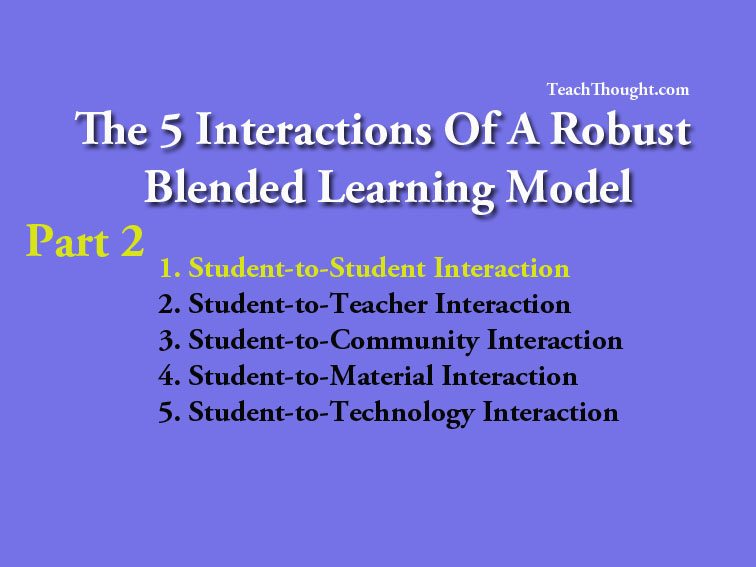Examining Blended Learning Models Through Student To Student Interactions
In part 1 of this 6-part series, Thomas Stanley looked at an overview of blended learning, specifically the critical interactions of a blended learning model. In part 2 below, Stanley looks specifically at student-to-student interaction, and the reality of synchronous and asynchronous access.
by Thomas Stanley, Project Learning LLC
Student-to-Student Interaction
Used to expand the students’ education and learning experiences, the student-to-student exchange is a critical part of a quality online class. There are a series of important questions that need to be answered: What is the value of a student-to-student relationship in the online world? What expectations should a school or program have about the depth and breadth of student interaction? How do synchronous and asynchronous tools add to the interactive online experience?
What is the value of intensive student-to-student exchanges? Teaching a student to be a functioning member of a collaborative learning group at a distance is a key 21st century skill. For students to go online and meet with others, post their ideas, defend and challenge others’ viewpoints, find or use outside experts to support their ideas, build on others’ ideas, and present/defend their own opinions in a thoughtful, logical, and timely manner is a real-world skill that should not be overlooked by online educators. In order to create this very interactive learning exchange, students should include a balance of asynchronous and synchronous lessons or activities. It is also important for students to achieve the academic and technical skills that are as an important as learning to read. Students can blog or post on Facebook or Twitter, but can they carry out an extended academic discussion?
What expectations should a school or program have about the depth and breadth of student interaction? How do synchronous and asynchronous tools add to the interactive, student, online experience? Asynchronous tools have always served as the most valuable part of a virtual learner’s educational experience. This tool gives students a chance to express their ideas in a flexible learning situation. If done correctly, students develop important critical thinking skills because they have to think about what they want to say, how they want to say it, and who/what supports their ideas.
 As students begin to do these traditional online discussions, they also can meet and discuss ideas with real world experts, do high level projects and activities together, and post an array of multimedia materials to support what they do. As long as these projects are done in a timely manner, with the depth and quality that it takes to learn, it is worth everyone’s time to participate in these forums.
As students begin to do these traditional online discussions, they also can meet and discuss ideas with real world experts, do high level projects and activities together, and post an array of multimedia materials to support what they do. As long as these projects are done in a timely manner, with the depth and quality that it takes to learn, it is worth everyone’s time to participate in these forums.
The mission of the teacher is to help the students by making available an array of activities and multimedia within the lessons. The teacher’s ability to know when and how to work with the discussion forums and Web resources is an essential part of the quality of these discussions. In the asynchronous world, students can be challenged to do a range of academic tasks that can include so much more than “just a discussion.”
Synchronous instruction is also a valuable part of the online experience as long as the tool is used in an interactive manner. It is a place where the students’ ideas and opinions should be used in conjunction with the asynchronous lessons. This tool can and should be used to do collaborative, inquiry activities that bring experts from around the world for the student to work with. It allows students to do real-time mobile events that are interactive, it permits students to work in a “face-to-face” environment where they can share applications, get immediate feedback to questions, follow-up on that “teaching moment” opportunity, and either begin or end the inquiry process in conjunction with the lessons of the asynchronous tools.
Other uses of the synchronous tool are as follows: allow students to be tutored; bring in district, state, or world resources to help or evaluate different types of students (such as English Language Learners, special needs students); and give parents a chance to meet with teachers, counselors, and/or administrators without having to physically “come in to the school.”
When a student-to-student interactive learning environment is created, it is an amazing educational experience where students begin to express their ideas on academic subjects in a meaningful way. By blending two powerful, online tools, asynchronous and synchronous, the online teacher can create a very rich academic environment.
In part 3 of this series, we’ll look at the interactions between the student and teacher, specifically the role of the teacher in a blended learning model.

